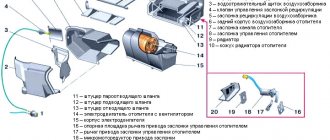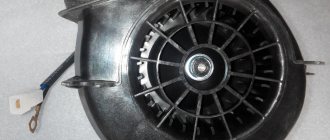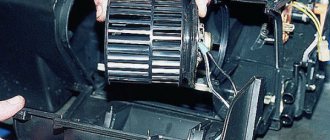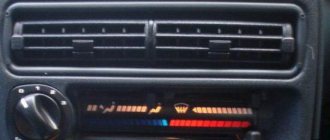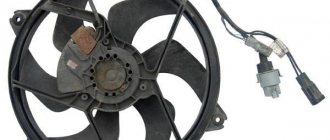As soon as the first cold weather arrives, some drivers are faced with a non-working stove in their VAZ 2110. The reasons may be different, malfunctions in mechanics and electronics.
To find out the causes of the breakdown and fix the problem, first of all you should study the Lada heating system and the essence of the stove’s operation.
In the course of their work, the mechanics were able to identify a number of the most common causes of a non-working stove on a VAZ 2110:
- the heater operates in one temperature mode at a certain speed or the temperature is not regulated at all;
- the shutters responsible for air distribution and then do not work;
- breakdown of the damper temperature sensor (located on the ceiling of the car);
- breakdown of the SAUO controller;
- Antifreeze heater radiator leaking.
Once all of the above points have been diagnosed and the cause of the stove failure has been determined, you can proceed directly to the repair.
Checking the operation of the automatic control system
To diagnose this system, you need to have a multimeter so you can measure the current on the pink and brown wires.
The voltage can have different values, it depends on which controller is built into the car. For example, in older cars - before 2002 - heater control controllers 1303.3854 were installed, in this case the voltage at the minimum position changes in about 14 seconds, and at the maximum value it is supplied stably. Therefore, if the voltage of the ACS unit at the output has a constant value, it is faulty. On newer cars since 2003, the built-in unit is 1323.3854, and the stove is 2111-8101012.
When faults are found in the controller, the dampers may be faulty. To determine other reasons for the breakdown of the car's 2110-12 heater, you will most likely need to disassemble the heater.
We identify the cause of the breakdown
First, you need to figure out the reason why the stove fan is not working. There may be several of them.
- A faulty fuse is the most common, simple and most common reason that the motor does not turn. On the one hand, replacing a fuse is not a big and difficult problem, which can be easily handled even by a beginner. But on the other hand, it will be necessary to find the reason why the fuse has become unusable. And to do this, you will need to examine the electrical circuit that ensures the normal operation of the heating system for the presence of a short circuit. Since we are talking about fuses, it would be useful to know that the operation of the stove on the VAZ-2110 depends on fuse F7 with a current strength of 30 amperes. Also, the operation of this fuse determines the illumination of the glove compartment, the functioning of the cigarette lighter, the electric motor from the headlight washer and the heated rear window. If a short circuit is not found in the electrical circuit of the heating system, then the cause will need to be looked for throughout the wiring.
- Problems with the contacts that are located inside the mounting block are a common reason for the VAZ heater motor not working. To identify this problem, you can move the block with the attached harnesses while the car is running. If the VAZ-2110 heater fan starts working, then it is necessary to remove the block and clean the contacts.
Diagnostics of heater system shutters VAZ 21I0
The VAZ 2110 stove has two shutters.
Through one, cold air is absorbed, and through the other, hot air is supplied. If the wire mechanism malfunctions, you may encounter the following disadvantages:
- The stove doesn't heat well
- There is no hot air flow at all,
- high air supply temperature,
- temperature is not regulated.
Shutters can have various types of breakdowns:
- It happens that the damper gets stuck or malfunctions, and the micromotor gearbox can also fail.
- Also, the damper may stop functioning due to rust, because there are two types of dampers.
There are old and modern samples of shutters,
- old ones - made of plastic and sealed with foam rubber,
- and modern ones are made of metal with a rubber seal.
If you cannot hear the damper operating, then try moving it after removing the deflector.
The disadvantage of metal dampers is that breakdowns often occur due to rust, while plastic ones tend to deform due to the supply of hot air.
In the case where the shutters do not move at all, diagnose the microdetector.
Fan replacement
If the problem still lies in the fan itself, then it would be best to replace it with a new one. The stove fan can, of course, be repaired, but this may involve, for example, replacing the brushes. It simply doesn’t make sense to carry out more comprehensive repairs, since you can’t hope for long-term service for such a part. Replacing a VAZ-2110 stove fan requires selecting a new part. There are two options here: find an old-style part or buy a new spare part. The second option is more acceptable and accessible.
The replacement process is not as complicated as it might seem. It is enough to be able to work with standard tools, have free time and have the desire to tinker with your own machine. To replace a faulty fan, you must follow the following work plan:
- Open the hood and remove the battery negative terminal.
- We remove the windshield wipers by prying and dismantling the rubber caps. Using a 10mm wrench, unscrew the nuts and remove the brushes.
- Using a slotted screwdriver, pry up the decorative plugs, unscrew the screws on the frill and the nuts on the edges. Now we can remove the frill.
- Under the rubber seal you can find screws that hold the shield from the engine compartment. We also unscrew them.
- We dismantle the hose through which washer fluid is supplied to the injectors.
- On the right side of the engine compartment, there are two nuts on the bottom side that fit a 10mm socket wrench. They are difficult to get to, but you don’t have to unscrew them all the way, because with a few turns the shield can be easily removed.
- It is necessary to remove the clamps from the hose that connects to the vacuum booster of the brake system in advance.
- There are four self-tapping screws on the cabin filter cover; after unscrewing them, you can easily remove it.
- Already at this stage the outlines of the stove motor are visible. But you will also need to disconnect the block on the heating system motor and on the resistor.
- After the work has been done, it becomes possible to dismantle the left side of the stove along with the motor.
- A new part is installed in place of the damaged element, and assembly is carried out in the reverse order.
If you have never had to remove a heating system fan before, this process may take several hours. But in the future, any problem with the heating system can be fixed much faster. Even if something doesn’t work out for you during your work, you don’t need to stop trying to achieve a positive result. Over time, everything will definitely work out.
Checking the micro-reducer of the stove shutter
To check the shutter drive, have an ohmmeter with you.
In old-style automatic control system controllers, the resistance at the minimum value of blue current should be from 850 to 1250 Ohms, in modern ones - 3.4-5.6 kOhms. If you want to check, you need to set the air supply temperature mark to the minimum value and hold for about 20 seconds. Disconnect the controller connector and, with the motor running, measure the difference in resistance in contacts XI.4 and XI.1. At the maximum temperature value in old controllers, the multimeter shows a resistance of 3.1 to 5 kOhm, in new ones - 1.3-1.5 kOhm. If the resistance does not change the readings or is absent altogether, this will indicate a malfunction of the micro-reducer shaft location sensor, which is associated with erasing the tracks, or a malfunction of the automatic control system itself, as a result of which no current flows to the micro-reducer.
In order to replace the micro-reducer you need to disassemble the stove.
Temperature is not adjustable
If you cannot adjust the temperature of the air supplied to the cabin, then you need to look for the reason in the damper or control unit. It is possible that the temperature sensor, which is located on the ceiling, next to the ceiling lamp, has failed.
To check it, you need to turn the regulator to the right all the way, then bring your hand to the air flow coming from the heating system. If warm air flows only when the regulator is in the maximum heating position, then the sensor itself (or even the regulator) needs to be changed.
If heat also occurs in other positions of the regulator (in the red part), then the sensor is not at fault.
After this, you need to check whether the damper is stuck. They approach it through the engine compartment: remove the central deflectors and move the damper by hand. If you have to remove it, it is better to replace the plastic one (it comes standard) with aluminum, which is not so prone to deformation and freezing.
An article dedicated to the repair of the damper in the VAZ 2110 is located here:
Recommendations for operating the stove in VAZ 2110-2112
If the vehicle is used frequently, it is recommended to regularly replace the cabin filter. If it is clogged or completely missing, in addition to dust in the cabin, the risk of dirt and dry leaves getting into the heater motor increases. Prolonged operation of the fan in such conditions leads to its failure.
When the motor operates exclusively at high speeds (if the resistor is faulty, this is especially true), the electric motor wears out quickly, so you should not delay replacing the faulty resistor.
To visualize the causes of the malfunction, you can watch a video on this topic. If desired, all problems with this element can be resolved independently.
Similar articles:
- Stove design
- How to remove the instrument panel, tuning, modifications
- The stove doesn't heat well
- Replacing the stove radiator
- Replacing the stove motor
For what reasons may the fan stop functioning?
As a rule, the majority of problems that are directly related to a heating device that refuses to function normally can be identified by a motorist only with the onset of winter. Only in cold weather can a malfunction appear, consisting in poor heating of the interior or the banal impossibility of changing the location of the speed mode switch.
Experienced specialists, through whose hands more than one domestic “ten” has passed, call problems with the stove, and in particular, the incorrect operation of the SAUO unit, a real disease of the VAZ-2110. With such a problem, the car owner simply cannot switch the Nth speed of the stove. Let's figure out how to remove the heater switch on a VAZ-2110 and repair the system.
The automatic heater control system plays an important role in the life of the stove. The device controls the damper according to a certain principle: the information received by the device regarding the temperature difference is fed to the controller. The damper closes or opens in accordance with incoming signals that appear on a small gear motor that drives it.
As for the performance of fan speeds, everything is not simple here. A low rotation speed is ensured by an additional resistor with two spirals, the resistance of which is 0.23 and 0.82 Ohms. If the electric motor of all available spirals is activated, the first fan speed begins to function.
A spiral with a resistance of 0.23 Ohm is responsible for the functionality of the second rotation speed of the unit. If only the electric motor works (the resistor is inactive), the fan rotor switches to third speed with a frequency of 4100 rpm.
The heating device, which is installed in the domestic VAZ-2110, is a separate system consisting of several devices. The main element of the design is the unit, the functioning of which determines the preparation of the air flow entering the vehicle interior.
The stove block is located under the hood of the car, with its help the speed at which the air flows, as well as its temperature, is adjusted. In addition to the central unit, the system includes an air distributor. It is worth noting that all the air ducts that are on the VAZ-2110 are located inside the car on the instrument panel.
The Volga "ten" is equipped with a special stove "2110-01", which differs from other models in the presence of an evaporator in the standard climate control device. In the article we will look at the reasons why the VAZ-2110 stove mode switch does not work, and we will also provide instructions for troubleshooting problems that have arisen in each of the units.
Experienced specialists, through whose hands more than one domestic “ten” has passed, name problems with the stove, and in particular, the incorrect operation of the self-propelled automatic control unit. real disease VAZ-2110. With such a problem, the car owner simply cannot switch the Nth speed of the stove. Let's figure out how to remove the heater switch on a VAZ-2110 and repair the system.
If the car heater fan stops working, then several main causes of the malfunction should be analyzed. The fuse may have become unusable. It is a burnt-out part that most often damages the stove fan. And although replacing it is quite easy even for a car owner with little experience, this event is quite troublesome and time-consuming.
- Glovebox.
- Cigarette lighter.
- The system responsible for heating the rear windows and mirrors.
- Headlight washer.
Poor quality assembly of the internal parts of the main mounting block is also often the cause. It happens that the fan fails or poorly blows warm air into the cabin due to internal oxidation of the contacts, which occurs when the main unit of the car furnace is poorly assembled.
To make sure that the cause of the malfunction is oxidation, you need to move the device flagella along with the block to which they are attached with a little force. If during this manipulation the device begins, albeit weakly, but still to force warm air into the car interior, then to repair the fan it will be enough to remove the block, clean all the contacts and install it in its original place.
The central unit in the stove system is the heating unit. Its main function is to directly heat the interior. This block is arranged as follows. An electric motor with fan blades pumps hot air, three dampers perform the function of recirculation and closing/opening the channels.
There is also a heater core. On modern new generation systems, heat exchangers are not equipped with a tap. Therefore, the radiator is always heated, regardless of the time of year. The manufacturer claims that this has solved the problem with constant faucet leaks. In addition, heating of the interior is significantly faster. In summer, supply ventilation occurs outside the radiator.
This will be indicated by noise or strong squealing while the car is moving. First you need to find out what is causing the fan failure. In some cases, the lower part on the heater housing falls off. Then the hooks are installed in place, which serve as fastenings. However, it is more common to see broken tabs on the heater unit housing.
Here the housing needs to be replaced. Another reason is uneven shaft expansion coefficients if the fan is heavily worn. In this case, experts recommend replacing the stove motor or its bushing. Sometimes the fan makes noise because of the washers, which are used to eliminate axial play. The element needs to be removed and cleaned. Replace the washer with a fluoroplastic one, then lubricate everything well.
Each fan speed (except the last) is connected through a separate heater resistor. It is located not on the controller, but under the frill. One of the reasons for the inability to work at first speed is a faulty resistor. If the second speed does not work, then the reason is the same.
If the third fan speed is the last (this is the case on older units), then it is connected without a resistor. Problems may lie in the contacts of the automatic control system. Below we will talk in more detail about it.
DETAILS: How to check the idle speed sensor and identify faults? || Idle Air Controller IAC - Malfunction Device Check
Structurally, the fan consists of a DC electric motor with a commutator-brush assembly and an impeller mounted on the electric rotor. motor. The electric motor is powered from the vehicle’s on-board network. There are several modes of fan operation, the difference between which comes down only to the rotor rotation speed, and this is realized by inserting a resistor into the power supply circuit of the electric motor.
The fan operating mode is set using a handle located in the heater control unit on the center console. Initially, on the VAZ-2110 this handle was part of the design of the SAUO controller, but functioned separately from the controller itself.
The electric motor used in the design of the VAZ-2110 fan is simple, but it has “weak points” - the commutator-brush assembly and bearings. Wear of these elements causes incorrect operation and complete inoperability of the fan. Short circuits and winding breaks in the stove drive are rare, but don’t forget about these breakdowns either.
Symptoms of failure. Heater components that affect fan operation
Signs of a malfunctioning stove fan are quite obvious and impossible not to notice. Common symptoms of failure:
- Increased noise, grinding noise during operation.
- Significant reduction in air injection efficiency.
- The fan does not turn on.
- Spontaneous change in the rotation speed of the electric motor.
- It can be determined by ear that the electric motor is operating under heavy load.
In some cases, such consequences result from malfunctions in the power supply and fan control circuits, so you should check them first. This applies to:
- fuse (blowout is the cause of complete failure of the electric motor);
- resistor (if it is faulty, some speed modes of the electric motor stop working);
- controller (the knob for switching fan modes is part of its design, so malfunctions of the automatic control system affect the functioning of the electric motor);
- wiring terminals of the power and control circuits (oxidation, damage to wires is one of the reasons for a malfunctioning electric fan).
If diagnostics of these elements shows that they are in good working order, it is necessary to dismantle and repair the fan itself. But it can be diagnosed first.
Fan check
The test is done by directly powering the electric motor from the battery (we lay wires from the battery terminals and connect them to the power terminals of the motor) - operation under load, difficulty gaining rotation speed, squeals and squeaks indicate wear of the drive components and the need to replace them.
Design features of the stove of the old and new models
The design of the electric motor of the stove on the VAZ-2110 is identical, but the fans and their location are different. On models of the first years of production, the electric fan is installed in the stove housing in front of the radiator and it is located horizontally (old-style stoves).
